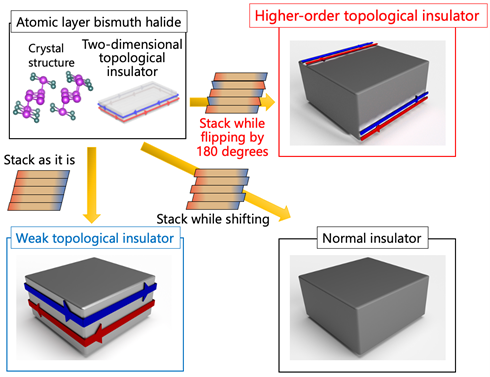Jan 5 2021
The term spintronics denotes a range of physical systems that could be the alternative for various electronic systems someday. Achieving this generational leap requires material components that can limit electrons in one dimension.
 Topological Insulators. Subtle changes in the arrangement of component materials can have a stronger knock-on effect to the bulk material than was previously thought. Image Credit: © 2020 Kondo et al.
Topological Insulators. Subtle changes in the arrangement of component materials can have a stronger knock-on effect to the bulk material than was previously thought. Image Credit: © 2020 Kondo et al.
For the first time, scientists have formulated such a material in the form of a unique bismuth-based crystal called a high-order topological insulator.
The development of spintronic devices requires the designing of new materials that leverage the quantum behaviors not observed in day-to-day life. All are perhaps familiar with conductors and insulators, which allow and limit the flow of electrons, respectively. Semiconductors are common but not so familiar to some; these are generally insulators but turn into conductors under specific conditions, which makes them perfect miniature switches.
Spintronic applications require a novel type of electronic material known as a topological insulator. It varies from the other three materials by acting as an insulator throughout its bulk, though it is a conductor along its surface.
Moreover, it does not conduct the flow of electrons themselves, but an attribute of them called their spin or angular momentum. This spin current could pave the way for a whole new range of low-power and ultrahigh-speed devices.
But not all topological insulators are the same: Researchers have already created two types—strong and weak—but they have certain disadvantages. Since they are conductors of spin along their whole surface, the electrons at the surface tend to scatter, weakening their potential to convey a spin current.
However, since 2017, scientists have proposed a third type of topological insulator known as a higher-order topological insulator. A team of researchers from the Institute for Solid State Physics at the University of Tokyo has created such a topological insulator for the first time.
We created a higher-order topological insulator using the element bismuth. It has the novel ability of being able to conduct a spin current along only its corner edges, essentially one-dimensional lines. As the spin current is bound to one dimension instead of two, the electrons do not scatter so the spin current remains stable.
Takeshi Kondo, Associate Professor, Institute for Solid State Physics, University of Tokyo
Kondo and his colleagues created this three-dimensional crystal by stacking one-atom-thick, two-dimensional slices of crystal in a specific way. All the crystal slices in the stack are oriented in the same way, such as playing cards face down in a deck, for both strong or weak topological insulators.
However, the orientation of the slices was alternated—or the metaphorical playing cards were faced up then down repeatedly throughout the stack—to develop the higher-order topological insulator. Such a slight change in arrangement leads to a huge change in the behavior of the three-dimensional crystal that results.
A quantum mechanical force known as the van der Waals force holds the crystal layers in the stack together. This is one of the unusual types of quantum phenomena that are actually observed in everyday life, as it somewhat governs how powdered materials clump together and flow the way they do. In the crystal, it holds the layers together.
It was exciting to see that the topological properties appear and disappear depending only on the way the two-dimensional atomic sheets were stacked. Such a degree of freedom in material design will bring new ideas, leading toward applications including fast and efficient spintronic devices, and things we have yet to envisage.
Takeshi Kondo, Associate Professor, Institute for Solid State Physics, University of Tokyo
Journal Reference:
Noguchi, R., et al. (2021) Evidence for a higher-order topological insulator in a three-dimensional material built from van der Waals stacking of bismuth-halide chains. Nature Materials. doi.org/10.1038/s41563-020-00871-7.